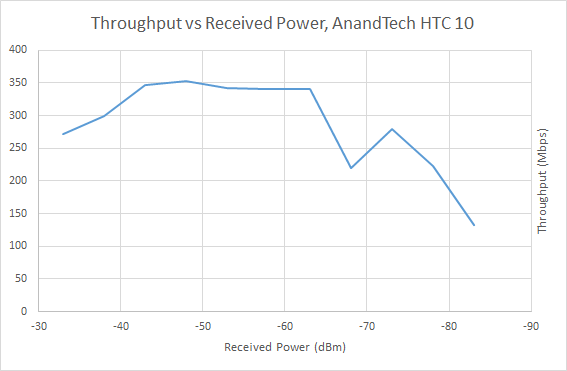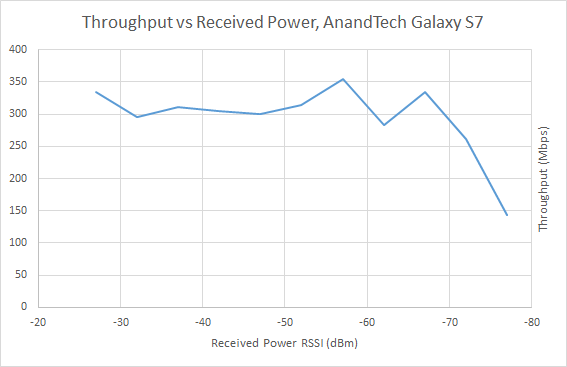The HTC 10 Review
by Joshua Ho on September 19, 2016 8:00 AM ESTWiFi Performance with Ixia IoT
As previously discussed, RF testing has always been a major unknown to some extent because environmental factors make it extremely difficult to tell exactly what is going on with the system. I don’t think it really needs to be said but previous reviews and any controversy regarding the quality of RF has always lead to a ring of confusion and back and forth with no clear-cut answers, at least in the public domain. The Transformer Prime and Pixel C reception issues have all been cases where I’ve seen a lot of confusion over whether a problem really existed in the hardware, software, or with the end user.
Most people really don’t have any understanding of how wireless transmission works, probably because it’s not really something you can see. As far as I know, no one is capable of seeing radio waves, even at high frequencies like 60 GHz. Of course, the problem is that for quite some time our testing was also not really ideal for seeing the quality of an RF implementation. While iPerf does provide some useful data, free space testing means that we’re dealing with channel conditions that inherently cannot be controlled. As a result, the only sensible test we could do with iPerf was focus on maximum throughput in the best conditions we could provide. The only thing that this can highlight is the upper bound of efficiency for WiFi due to the carrier sense multiple access scheme in most cases, and rarely detects a whole class of problems that affect user experience on WiFi.
In order to test these things we’ve moved to using a proper testing system that is actually used by at least a few OEMs today, namely Ixia IoT. While we discussed the possibilities for testing, at this time due to the RF isolation chamber used we are limited to AP simulation only, so we can’t properly simulate clients in the channel without restricting ourselves to a single spatial stream for both the AP and client. This wouldn’t be a very useful test if set up in this manner as most devices today that we’re testing have support for two spatial streams, and many routers have three or even four spatial streams at this point.
The first set of results we can talk about that will be of interest is rate vs range. This is a fairly simple test at a conceptual level, as it simply tries to see how well a device can maintain its performance in the face of reducing signal to noise ratio for a given modulation and coding scheme. This is a good high level test of how well a device can maintain a connection as reception degrades. In this test the HTC 10 had an initial RSSI of -28 dBm while the GS7 was at -21 dBm and the iPhone 6s at -22 dBm, which allows us to calculate the path loss and determine the RSSI as a function of the transmit power.
The results of this test are interesting to say the least. Off the bat, every device had different RSSIs measured, so this meant that everything had different levels of path loss. The HTC 10 seemed to have the most path loss, while the Galaxy S7 and iPhone 6s were functionally identical. However it looks like RSSI is really an insufficient metric here because while the iPhone 6s was able to reach maximum throughput using NSS 2 MCS 8, the HTC 10 and Galaxy S7 did its best at NSS 2 MCS 4 or 5. I suspect this may be just due to placement as device positioning strongly affects MIMO as receive-side spatial correlation reduces the gains that MIMO can provide. Regardless, the HTC 10 somehow manages to beat the Galaxy S7 through much of the curve, but for some reason suffers from a reduction in throughput at higher transmit power. It's worth mentioning though that this test doesn't allow for testing of antenna gain or similar tests. Given various levels of futzing about with the device positioning in the test chamber I'm fairly confident that the Galaxy S7 is consistently better with regard to path loss, so even if it doesn't perform as well at a given RSSI it tends to have a higher RSSI than the HTC 10 by about 5 dBm which is fairly significant. I'm hoping to get some true antenna efficiency measurements with 3D plots in the near future so we can really give some real data on everything relevant here but for now this test highlights fairly well how WiFi performance varies.
Finally, the other test that we can run at this time is the roaming latency test, which tests how well a device can hop from one access point to another as the received transmit power rises and falls. If you ever rely on WiFi to work as you walk around any building larger than a single apartment unit, you’re going to feel the effects of high roaming latency as VOIP calls or any real-time network application will either experience interruption or drop altogether if roaming is not implemented properly.

Like the Galaxy S7, the HTC 10 really struggles with WiFi roaming as it seems almost universal that Android OEMs aren't really paying attention to anything that we don't test. The HTC 10 tended to not fail handover as often as the Galaxy S7 with only one failure out of 64 trials and fairly consistent latency around 110ms though. This is a bit of a surprise considering that the HTC 10 is generally considered in the broader discourse to have worse WiFi across the board compared to the Galaxy S7. Considering how much smaller HTC is this is really kind of strange to see. Just about anything will outperform the Pixel C though. Either way, HTC still should improve here, especially when considering how most schools and offices need good WiFi to make up for areas with cellular coverage gaps.













183 Comments
View All Comments
ChronoReverse - Monday, September 19, 2016 - link
Thanks for the very indepth review. I already own the HTC 10 and like it a lot but I still like reading about the details like the wifi testing.Vagabondjonez - Monday, September 19, 2016 - link
thanks for getting this out Josh. Theres alot of things we could still talk about. The charge test always seem off to me. I know about varying conditions ,but the G5 can definitely top up in 1 hour and 19 minutes with included wall adapter in a 70° room on a plastic surface made partially of composite wood. Htc wont reveal the particular source of alluminum that theyre using,but its much softer than 7000 series when judging the various skuffs and corner drop my unit sustained. If you ever have the time ,it be great to speak more in depth. email :cyborgsoda17@gmail.comphilehidiot - Monday, September 19, 2016 - link
Aye, I too am grateful - a wait but I appreciate that once something is significantly delayed it makes sense to keep everything else on track and finish it when you can. The nagging will now end.Notmyusualid - Tuesday, September 20, 2016 - link
I too, give you my thanks.Having owned an M7, I was looking forward to this.
Cheers.
tangibleghost - Wednesday, September 21, 2016 - link
I think it's to your credit that you pushed it out, even if it's not going to help any early adopters make their decisions. It's good to have full reviews of all the major phone releases as a historical reference if nothing elseSomeDude2552 - Sunday, September 25, 2016 - link
Umm yes but fagPhones were reviewed instantly.mortimerr - Monday, September 19, 2016 - link
Not true at all. It's still the only worthwhile Android device, and if people aren't taken with the Pixel devices, will be the only one to get. It's only not more worthwhile due to price.But if your only measure of a quality of device is how many units its marketing is capable of selling, then you're reading reviews on the wrong site.
TheMysteryMan11 - Monday, September 19, 2016 - link
Smartphones have shelf life of 1 year. Majority of purchases are made in 1st quarter of any newly launched device in the android world.Nobody in their right mind is going to wait 7 months for a review no matter how good it is to make purchase decision. The fate of HTC 10 is sealed.
And it does matter what masses buy. Look at HTC, they broke their own promise of quick updates? Why is that? Not enough resources because not many are buying their devices?
Probably.
They promised 15 day update for A9. It was still a failure. And now even that is not happening.
Sales directly affect the future of the device and company. Specially someone as bloated as HTC which is used to being a huge corporation and finding it tough now.
I still come to Anandtech for PC component reviews. But waiting for phone review to pop up here on AT is pointless exercise.
Byte - Monday, September 19, 2016 - link
You can also come here for iphone reviews, because we all know you have to wait for those before purchase.TheMysteryMan11 - Monday, September 19, 2016 - link
Lets not divert to Apple's picket fenced garden shall we? :P